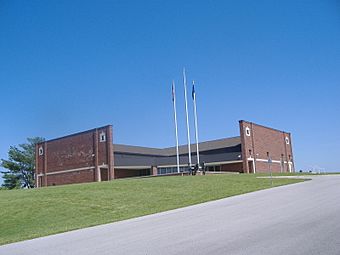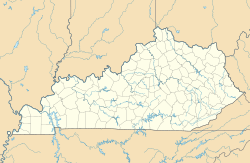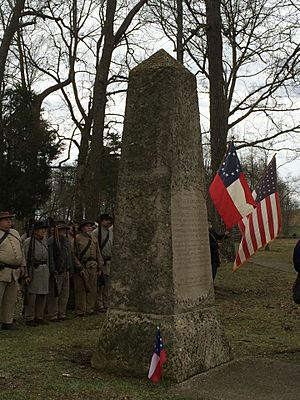Mill Springs Battlefield National Monument facts for kids
Quick facts for kids |
|
|
Mill Springs Battlefield National Monument
|
|

Visitor center
|
|
| Location | Pulaski / Wayne counties, Kentucky, US |
|---|---|
| Nearest city | Somerset, Kentucky |
| Area | 1,459.19 acres (5.9051 km2) |
| NRHP reference No. | 93000001 |
| Added to NRHP | February 18, 1993 |
The Mill Springs Battlefield National Monument is a special place in Kentucky. It marks where the Battle of Mill Springs happened in January 1862. This battle was an important event during the early days of the American Civil War.
This site was recognized as a U.S. National Historic Landmark in 1993. Later, in 2019, it was officially made a national monument. The National Park Service took over the land, and the monument officially opened on September 22, 2020.
Several other important places connected to the battle are also listed on the National Register of Historic Places. These include the Confederate Mass Grave Monument in Somerset, the Gen. Felix K. Zollicoffer Monument, the West-Metcalfe House, and the Mill Springs National Cemetery.
Contents
Exploring the Battlefield Area
The Mill Springs Battlefield covers a large area in Kentucky. It includes the main battlefield and two spots where Confederate soldiers built defenses. These areas are mostly in Pulaski County, Kentucky, with some parts in Wayne County, Kentucky.
The land looks a bit different today than it did in 1862. Back then, there were more trees. The town near the battle was called Logan's Crossing, but now it's known as Nancy. None of the buildings from the Civil War era are still standing.
The American Battlefield Trust and its partners have worked hard to protect this historic land. They have saved over 769 acres of the battlefield since 1993.
Visitor Center and Museum: Learning About the Battle
The Mill Springs Battlefield Visitors Center and Museum helps people learn about the January 1862 Battle of Mill Springs. This battle was a key moment in the American Civil War. The museum is in Nancy, Kentucky, right next to where the Union soldiers camped.
The museum is also close to the Mill Springs National Cemetery. This cemetery is where Union soldiers who died in the battle are buried. Confederate soldiers are buried nearby at Zollicoffer Park. The museum officially opened its doors on November 4, 2006.
The Mill Springs Battlefield Association runs the museum. Inside, you'll find a welcome area, a community room, a library, and an exhibition hall. There's also a gift shop where you can find souvenirs. The Brown-Lanier House, which was used as a headquarters during the battle, is also owned by the Association.
In 2013, a bill was introduced in the United States Congress to study making the battlefield a national park. Many people, including Kentucky Representative Hal Rogers, believed the battlefield was a "jewel" that deserved to be part of the National Park Service. This bill helped lead to the battlefield becoming a national monument.
The John D. Dingell Jr. Conservation, Management, and Recreation Act was signed into law on March 12, 2019. This law officially made the Mill Springs Battlefield a national monument. It was established once the National Park Service bought the necessary land.
Zollicoffer Park: A Place of Remembrance
Zollicoffer Park holds two important monuments that are on the National Register of Historic Places. These are the General Felix K. Zollicoffer Monument and the Confederate Mass Grave Monument in Somerset.
These monuments were inspired by a local girl named Dorotha Burton. She used to decorate a white oak tree in honor of Confederate General Felix K. Zollicoffer. He died in the battle because he accidentally rode too close to Union lines, thinking they were his own. The original "Zollie tree" was destroyed by lightning in 1995. However, a new sapling from that tree was planted in its place in 1997, continuing the tradition.
See also
- List of national monuments of the United States
- West-Metcalfe House, which was General Zollicoffer's headquarters before the battle. It is also listed on the National Register.





